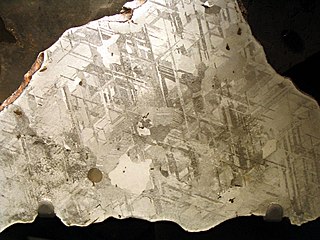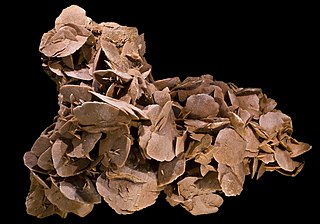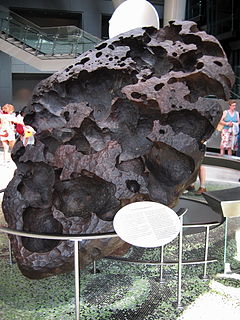| Lake Murray Meteorite | |
|---|---|
| Type | Iron |
| Class | Magmatic |
| Group | IIAB |
| Country | US |
| Region | Oklahoma |
| Fall date | 90 to 110 million years ago |
| Found date | 1933 |
| TKW | 600 pounds (270 kg) |
The Lake Murray Meteorite, the largest of its kind ever found in Oklahoma and now ranked as the fifth largest in the world, was discovered on a farm in Carter County, Oklahoma in 1933. At that time it was considered the largest known specimen in the world. The farm was sold to the state of Oklahoma about the same time for the creation of Lake Murray State Park, for which the specimen was named. The largest piece is on display at the park.

Carter County is a county located in the U.S. state of Oklahoma. As of the 2010 census, the population was 47,557. Its county seat is Ardmore. The county was named for Captain Ben W. Carter, a Cherokee who lived among the Chickasaw.

Lake Murray is a 5,700-acre (23 km2) lake in south central Oklahoma, near Ardmore named for Oklahoma Governor William H. Murray. It was created by damming Anadarche and Fourche Maline Creeks. The lake is wholly within Lake Murray State Park, Oklahoma's largest state park, containing over 12,500 acres (51 km²) of relative wilderness. A state-operated lodge and resort is located on the west shore that serves many visitors to the lake, and serves as a base for numerous cabin and campground facilities near the lake.
The meteorite was found on the site of Lake Murray State Park in 1933 by J. C. Dodson, Sr. The core was covered by a sheathing of iron oxide and shale that was about 4 inches (10 cm) thick on the exposed part and up to 6 inches (15 cm) thick on the buried part. [1] When the specimen was removed from the ground and the sheathing removed, the core measured 30 inches (0.76 m) long, 9 inches (23 cm) thick and tapered in width from 24 inches (61 cm) at one end to 9 inches (23 cm) at the other. It weighed 600 pounds (270 kg). [2]

A meteorite is a solid piece of debris from an object, such as a comet, asteroid, or meteoroid, that originates in outer space and survives its passage through the atmosphere to reach the surface of a planet or moon. When the object enters the atmosphere, various factors such as friction, pressure, and chemical interactions with the atmospheric gases cause it to heat up and radiate that energy. It then becomes a meteor and forms a fireball, also known as a shooting star or falling star; astronomers call the brightest examples "bolides". Meteorites vary greatly in size. For geologists, a bolide is a meteorite large enough to create an impact crater.

Iron oxides are chemical compounds composed of iron and oxygen. All together, there are sixteen known iron oxides and oxyhydroxides.

Shale is a fine-grained, clastic sedimentary rock composed of mud that is a mix of flakes of clay minerals and tiny fragments of other minerals, especially quartz and calcite. Shale is characterized by breaks along thin laminae or parallel layering or bedding less than one centimeter in thickness, called fissility. It is the most common sedimentary rock.
Allen Graffham, a geologist and curator of the park's Tucker Tower museum, was interested in a more scientific study of the object. He contacted Dr. Lincoln LaPaz of the University of New Mexico about the specimen. LaPaz confirmed that it was a meteorite. He assessed that it was composed primarily of nickel and iron, and estimated that it may have weighed 2,000 pounds (910 kg) when it struck, about 90 to 110 million years ago, but that oxidation had since worn away 5 to 6 inches (13 to 15 cm) of the surface. [2]
Lincoln LaPaz was an American astronomer from the University of New Mexico and a pioneer in the study of meteors.

The University of New Mexico is a public research university in Albuquerque, New Mexico. Founded in 1889, UNM offers bachelor's, master's, doctoral, and professional degree programs in multiple fields. Its Albuquerque campus encompasses over 600 acres (2.4 km²), and there are branch campuses in Gallup, Los Alamos, Rio Rancho, Taos, and Los Lunas. UNM is categorized as an R1 doctoral university in the Carnegie Classification of Institutions of Higher Education.
LaPaz, then the director of the Institute of Meteoritics at the University, carefully cut the specimen into two pieces. He performed additional tests and classed the specimen as octahedrite. He wrote that it could also be an example of a hexaoctahedrite (a transition between hexahedrite and octahedrite). [1] A more recent reference states that the meteorite is an iron meteorite belonging to Group IIAB, which can be classified as either a hexahedrite or a coarsest octahedrite. [3] Chemical analysis showed that the material contained 6.3% nickel (Ni), 0.5% Phosphorus (P), 53.9 parts per million (ppm) Gallium (Ga), 141 ppm Germanium (Ge), and 0.02 ppm Iridium (Ir). [4]

Octahedrites are the most common structural class of iron meteorites. The structures occur because the meteoric iron has a certain nickel concentration that leads to the exsolution of kamacite out of taenite while cooling.
One half of the specimen was retained at Lake Murray, where it has been displayed at the Tucker Tower museum since the early 1950s. [4]
The New England Meteoritical Service has posted several photos taken during analysis of the specimen. [5]














